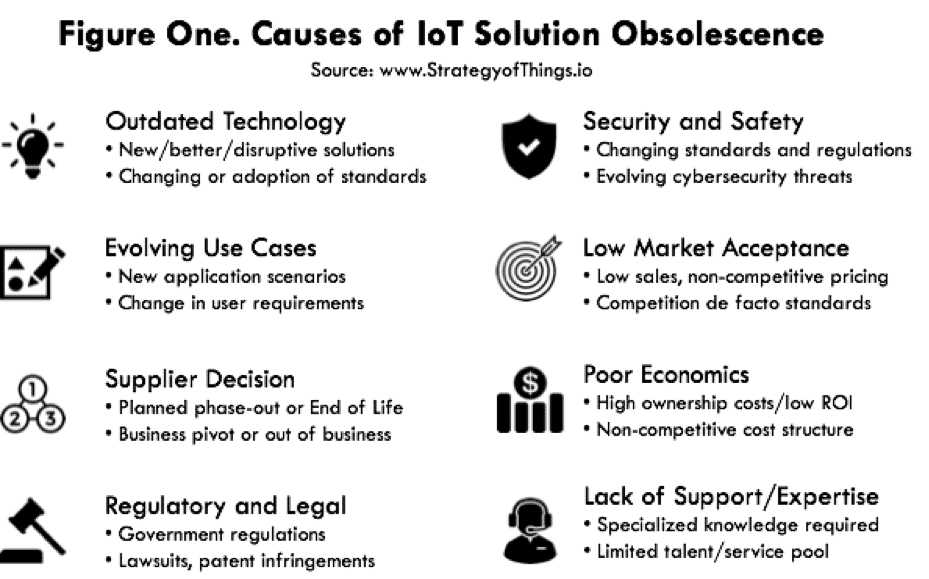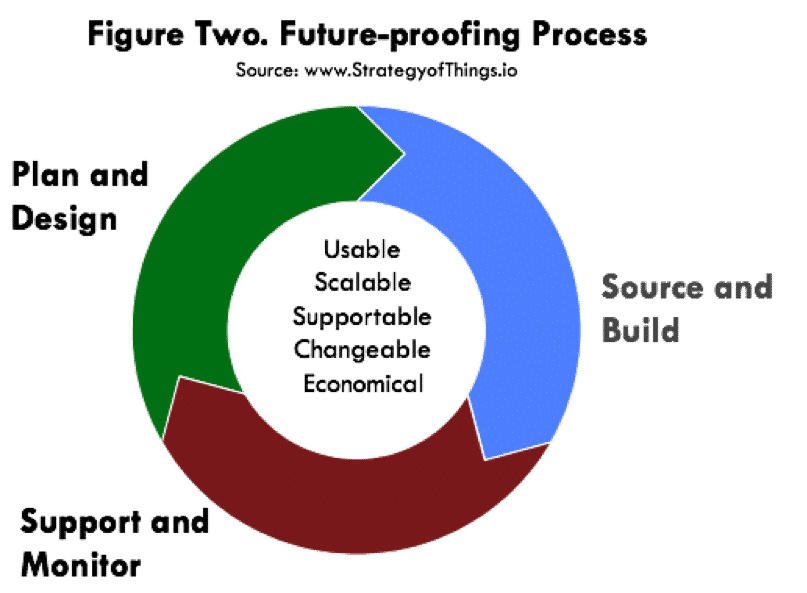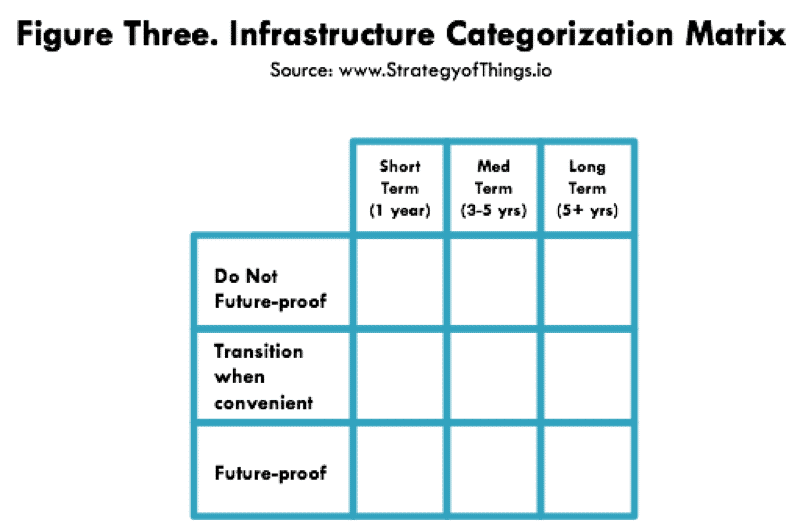How to Future-Proof Your IoT Infrastructure Investment
How to Future-Proof Your IoT Infrastructure Investment
- Last Updated: December 2, 2024
Benson Chan
- Last Updated: December 2, 2024



For all the value and disruptive potential that Internet of Things (IoT) solutions provide, corporate buyers face a dilemma. Today’s IoT technologies are still immature point solutions that address emerging Applications with evolving technology standards.
Buyers are concerned that what they buy today may become functionally or technologically obsolete tomorrow. Faced with this dilemma, many defer buying even if the IoT solutions they buy today offer tremendous value to their organizations.
This post discusses a planning strategy called “future-proofing” that helps managers, buyers, and planners deal with obsolescence.
What Causes IoT Solution Obsolescence?
An IoT solution, whether you buy it now or in the future, can become functionally obsolete for several reasons, as described in Figure One. Unlike more established technologies, today’s immature and fast evolving nature of IoT solutions, amplifies the risk of early obsolescence.
For example, today there are multiple Low Power Wide Area Network (LPWAN) connectivity options – SigFox, LoRa, RPMA (by Ingenu), Symphony Link (by Link Labs), NB-IoT and LTE-M. While each option has advantages and disadvantages, a subset of these will eventually “win” out as technology standards, business models, and Applications emerge.
Similarly, there are 350+ IoT platforms in the marketplace today. While many of these platforms target specific applications and industry segments, consolidation is inevitable as there are more vendors than the market can eventually support.
The major IoT platform vendors (Amazon, Microsoft, Google, IBM, GE, et al), currently on a market share land grab, will drive consolidation when they begin to acquire select vertical platforms to gain rapid access to those markets.
What is Future-Proofing?
According to Collins English Dictionary (10th edition), “future-proof” is defined as: “protected from consequences in the future, esp. pertaining to a technology that protect it from early obsolescence”.Because of the high cost of enterprise technologies, many buyers perceive obsolescence as bad. To them, future-proofing means keeping the technology as long as possible in order to minimize costs and maximize return on investment (ROI).
Their companies have standardized their business processes, policies, and even their technical support on the technologies that they have bought. When a solution goes End of Life (EOL) and transitions to a newer version, it means that managers will have to recertify and retrain everyone on the “new” solution all over again.
In general, transitions happen over a period of months (and sometimes years) in large global companies. During this time, multiple generations of the solution will co-exist, with each requiring different processes and policies.
In today’s fast moving IoT market, planned and unplanned obsolescence will be the norm for the foreseeable future. The traditional concept of “future-proofing” doesn’t apply, and can lead to significant, adverse business disruption.
In the era of cloud based solutions and IoT, future-proofing is not about outguessing the future, and choosing the “right” solution so as to never have to “buy” again. Nor is it overbuying technology now to avoid buying in the future. Finally, future-proofing is not about avoiding change.
Future-proofing is a solution lifecycle management strategy. It is a continuous process to maximize solution flexibility and options, while making deliberate choices and managing risk.
What Does a Future-Proof Interent of Things Infrastructure Look Like?
In planning the future-proofed IoT infrastructure, managers must first understand its key characteristics, and then define specific requirements for each of those characteristics. At a high level, these characteristics include:- Usable– the infrastructure and solutions achieve all functional needs with no loss in performance, security, service level agreements (SLA) over the desired time period.
- Scalable – supports future needs, applications, devices
- Supportable – resolves technical, performance, reliability, SLA issues
- Changeable – addresses “lock-in” and facilitates migration to updated solutions on your schedule based on your needs
- Economical – the total cost of ownership of the solution stays within forecasted ranges
How To Future-Proof Your IoT Infrastructure
Change is constant and cannot be avoided. The driving principle behind future-proofing is managing change, not avoiding or preventing it. This principle recognizes that every solution has a useful functional life, and that what is functional and useful today may be obsolete and discarded tomorrow.A properly designed future-proof plan provides the organization with options and flexibility, rather than lock-in and risk. It prevents suboptimal decision-making by managing the infrastructure on a system level, rather than at the individual component level.
Future-proofing your IoT infrastructure is a three step process (Figure Two). It is not a “once and done” exercise but must be done annually to remain relevant.

1. Plan and Design
The first step of the future-proofing process is to identify and place the various IoT infrastructure, systems and solutions into one of nine actionable categories. These categories are shown in Figure Three. The horizontal rows represent the “change” category, while the vertical columns represent the timeframe decision timeframe.
The actual classification of the IoT infrastructure solutions into one of the categories is determined in conjunction with IT, operations, and the business units. Key considerations for determining the “future-proof category” include:
- Usability/functionality – functional utility, compliance with standards, performance against needs, SLAs, and performance
- Scalability – ability to meet current and future needs, anticipated change in standards
- Support – resources, expertise, reliability
- Ease of transition –contractual agreements, technology interdependence/dependence, specialized skills
- Economics – maintenance costs, licensing/content/subscription fees, utilities, new replacement costs, transition costs
2. Source and Build
Once the proper categorization is completed, the second step is to procure the necessary solutions, whether they are hardware or software. This requires that a sourcing strategy be put into place over the desired time period.The terms sourcing and buying are sometimes used interchangeably, but they aren't the same. Sourcing is about ensuring strategic access to supply while buying is more transactional. In executing the future-proofing plan, procurement managers must understand the supplier product lifecycle, and develop specific tactics.
As an example, a large global company decides to standardize around a specific IoT edge device (and specific generation) and technology for the next five years. In order to maintain access to this supply during this time period, it employs a number of tactics, including:
- Stocking of spare units to be deployed in the future
- Placing large “Last time” orders before that version of the solution is discontinued
- Sourcing refurbished versions of the technology
- Incorporating leasing as sourcing strategy
- Negotiating contractual arrangements with the vendor to continue the solution line
3. Support and Monitor
The third step in the future-proofing strategy is to keep the IoT infrastructure and solutions operational over the desired time period. This is relatively easy when the solutions and technologies are being serviced and supported by the vendors.However, as vendors transition to newer technology and solution versions, buyers may find limited support and expertise. This problem is amplified the further you are from the original end-of-life date.
To keep the infrastructure and solutions fully operational during this time, companies must employ various reactive and proactive tactics. Some of these include:
- Incorporating and installing vendor firmware updates to maximize functionality, apply bug fixes and extend useful life. Vendors may issue firmware updates on both End of Life and current generation solutions.
- Purchase warranty and extended warranty and maintenance service contracts to assure access to support
- Develop in-house maintenance and repair capability
- Negotiate special one-off engineering support services with the vendor or their designated contractors
The Most Comprehensive IoT Newsletter for Enterprises
Showcasing the highest-quality content, resources, news, and insights from the world of the Internet of Things. Subscribe to remain informed and up-to-date.
New Podcast Episode

Using IoT to Modernize Infrastructure
Related Articles


